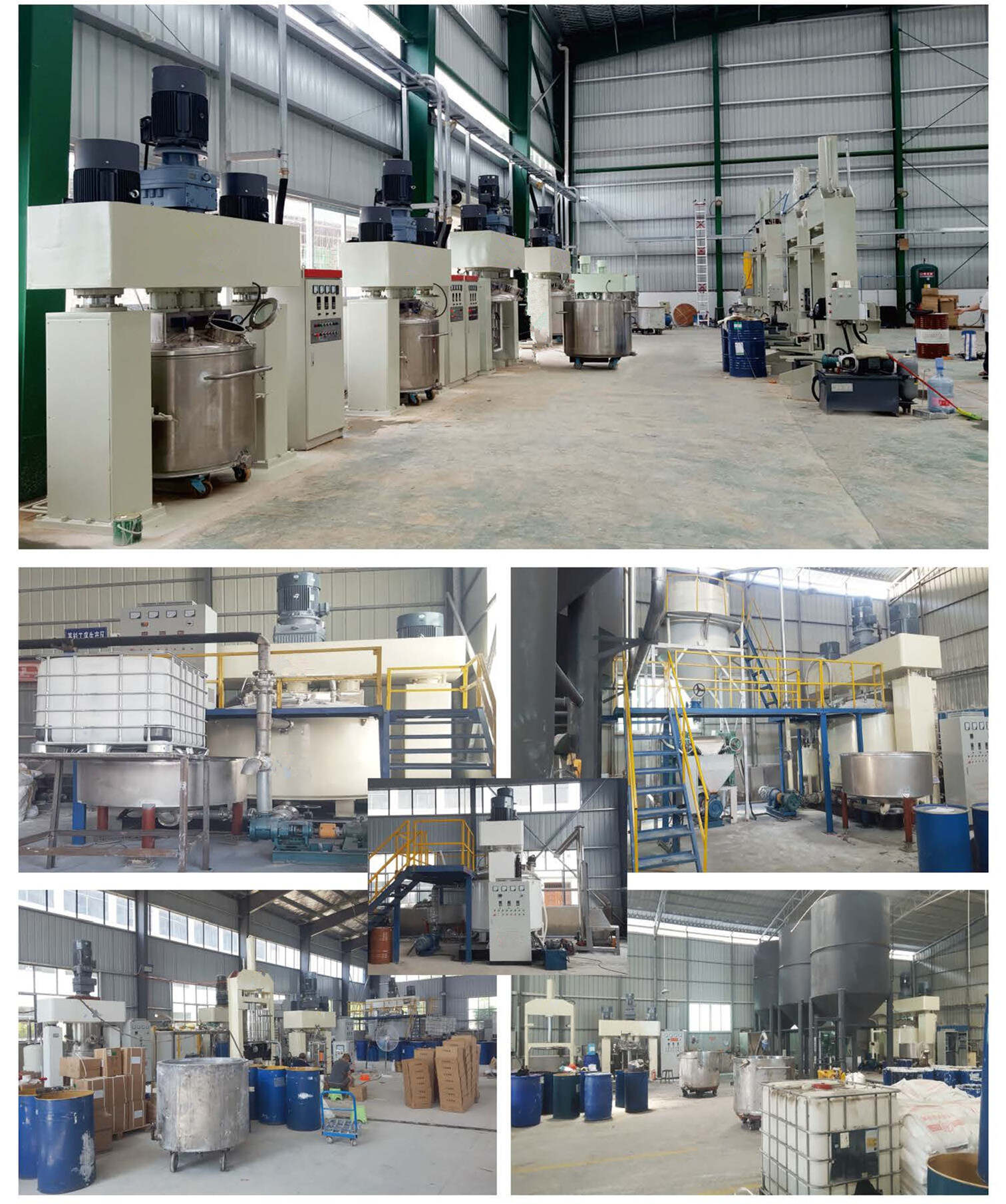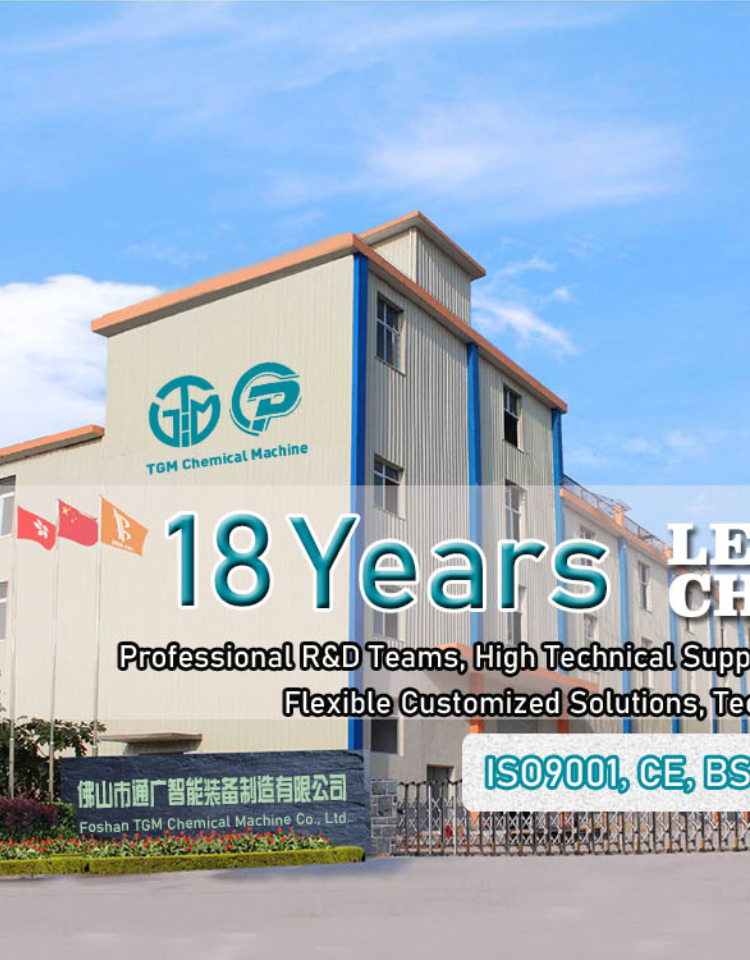Email cannot be empty
Password cannot be empty
Email format error
Email cannot be empty
Email already exists
6-20 characters(letters plus numbers only)
The password is inconsistent
Email format error
Email cannot be empty
Email does not exist
6-20 characters(letters plus numbers only)
The password is inconsistent


Precautions and operational details for the production of silicone sealant
I. High-Power Disperser
Operating Precautions:
Pre-Startup Check:
- Ensure the stirring blade is secure and no foreign objects are left in the kettle (especially acidic materials that may corrode residues).
- Check the hydraulic system oil level, and ensure the jacket cooling water circulates normally (to prevent resin from curing prematurely due to high temperature).
- Test the vacuum pump for sealing; the vacuum must be stable at -0.095 MPa or higher.
Material Addition and Operation:
- Add materials in phases: first add liquid resin, then gradually add fillers (such as calcium carbonate and silica) to avoid clumping of powder.
- Speed Control:
- At low speed (300 RPM), pre-mix for 1-2 minutes, then switch to high speed (1000 RPM) to disperse for 15-20 minutes.
- If the viscosity of the acidic material is too high, reduce the speed or handle in batches to prevent motor overload.
- Temperature Monitoring: Maintain temperature at ≤ 40°C through jacket cooling water, with automatic alarms shutting down if overheating occurs (to prevent decomposition and volatilization of acidic substances).
Shutdown and Cleaning:
- Immediately clean the stirring blades and kettle walls with a neutral solvent (such as ethanol) after discharging to prevent acidic residues from corroding the stainless steel surface.
- Regularly check the sealing rings on the stirring shaft; if leaking is found, replace with acid-resistant fluororubber seals.
II. Planetary Power Mixer
Operating Precautions:
Mixing Stage Control:
- When adding hardener, switch to low speed (50-100 RPM) and turn on the vacuum defoaming (to prevent bubbles affecting the sealing glue's density).
- Mixing time should be adjusted according to the formula, typically 20-30 minutes; excessive mixing may lead to a decrease in viscosity.
Safety Measures:
- The mixer cover must be completely closed and locked before starting to prevent material from splashing during high-speed operation.
- If the material contains flammable solvents (such as acetone), ensure the system is equipped with explosion-proof motors and static discharge devices.
Maintenance Points:
- Check the gap between the planetary mixing blade and kettle wall weekly (standard ≤ 2 mm); too large a gap will lead to uneven mixing.
- Replace high-temperature lubricating grease in the gearbox quarterly to avoid corrosion of gears by acidic gases.
III. Semi-Automatic Filling and Capping Machine
Operating Precautions:
Filling Accuracy Control:
- Before the first use, carry out 3-5 empty filling calibrations with actual materials, adjusting the piston stroke to an error of ≤ ±1%.
- Regularly clean the filling head filter mesh (150 mesh) to prevent filling material particles from clogging and causing unstable output.
Capping and Sealing:
- Adjust the capping pressure based on the packaging container material (plastic bottles/aluminum tubes):
- Plastic bottles: Pressure 0.2-0.3 MPa to avoid deforming the bottle neck.
- Aluminum tubes: Pressure 0.4-0.5 MPa to ensure the seal is smooth with no burrs.
- Take random samples of 3-5 units per batch to test sealing (using extrusion method or vacuum testing).
Emergency Measures:
- If leakage occurs during filling, immediately press the emergency stop button and use a scraper to clean the residual glue on the track to prevent the device from getting stuck after curing.
- At the end of each workday, lubricate the guide rails with silicone oil to prevent corrosion of metal parts by acidic vapors.
IV. Auxiliary Equipment Precautions
-
Hydraulic Press:
- Confirm that the discharge valve is fully open before pressing to avoid excessive back pressure that could damage the hydraulic cylinder.
- Use acid-resistant hydraulic oil (e.g., HFDU series) and replace it every 500 hours.
-
Vacuum System:
- The exhaust port of the vacuum pump must be connected to an exhaust treatment device (activated carbon for adsorbing acidic gases) to comply with environmental regulations in Europe and the US.
- Regularly check the sealing of vacuum pipes; if vacuum time exceeds 10%, the sealing ring needs to be replaced.
-
Cooling Water Tower:
- Maintain the pH value of circulating water between 6.5-7.5 to prevent pipe corrosion caused by dissolved acidic gases.
- Drain the water tank during winter shutdown to avoid freezing and cracking of the heat exchanger.
V. General Safety Regulations
Personnel Protection:
- Operators must wear acid-resistant gloves (butyl rubber), goggles, and gas masks (when handling volatile acidic substances).
- Set up anti-slip mats and emergency washing devices around the equipment (to respond to glue leaks).
Environmental Management:
- Install pH monitoring alarms in the workshop to prevent exceeding acidity gas concentration limits (EU/US standard: H₂S ≤ 10 ppm).
- Store waste glue and cleaning solvents classified as hazardous materials, and entrust compliance organizations for disposal.
Documentation:
- Fill out the "Equipment Operation Log" daily to record temperature, vacuum level, abnormal alarms, and other data.
- Retain records of key components replacement (such as sealing rings and filters) for after-sales claims or maintenance traceability.

